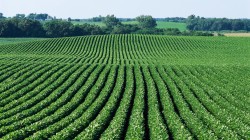Wet Spring Affecting 2013 Crop Mix

You don’t have to look very hard to see how wet it has been this spring. All over the Midwest and Mid-South, many crop fields have standing water patches. Others look relatively dry, but show no signs of any seedlings (a sure sign they have yet to be planted).
In my neck of the woods in Northwest Ohio, the crop fields around my home are mostly planted, but the crop mix is different than in years past. Where corn usually is the norm, many fields here have soybean plants coming up in them instead – an indication to me that the area’s growers couldn’t get their corn seed in the ground soon enough and decided to switch to soybeans instead.
And this area profile seems to parallel that on the national stage as well. According to a USDA report released last week, the agency has reduced its 2013 U.S. corn plantings forecast 1.5 million acres and raised its soybean acreage 700,000. These changes are being made “due to persistent spring rains,” said the report. Through the report, corn plantings were at 95% complete, down 3% from their five-year average. Likewise, soybean plantings were at 71% complete, down 13% from their five-year average.
Despite this news, however, USDA is predicting the U.S. corn crop for 2013 will top 97 million acres – the highest total since the 1930s. Furthermore, both corn and soybean prices have remained at high, so thus far, growers don’t seem to be phased, say ag retailers.
“Right now, everyone is disappointed in how slowly seeds are going into the ground, but I hadn’t had any cancellations or shifts in my crop input mix just yet,” said one Midwestern ag retailer. “But we will see what happens as the calendar turns over to July.”






